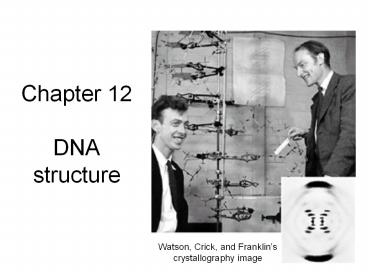Chapter 12 DNA structure - PowerPoint PPT Presentation
1 / 25
Title: Chapter 12 DNA structure
1
Chapter 12DNA structure
Watson, Crick, and Franklins crystallography
image
2
How did scientists know that DNA carries the
information for life?
- Many thought that proteins instead of DNA were
inherited from parent to offspring. - Scientists (Griffith, Hershey, and Chase) showed
that DNA actually carries the blueprint.
3
Griffiths experiment
Heat-killed, disease-causing bacteria (smooth
colonies)
Harmless bacteria (rough colonies)
Control(no growth)
Harmless bacteria (rough colonies)
Heat-killed, disease-causing bacteria (smooth
colonies)
Disease-causing bacteria (smooth colonies)
Dies of pneumonia
Dies of pneumonia
Lives
Lives
Live, disease-causingbacteria (smooth colonies)
4
Hershey and Chases experiment
Bacteriophage with phosphorus-32 in DNA
Phage infectsbacterium
Radioactivity inside bacterium
Bacteriophage with sulfur-35 in protein coat
Phage infectsbacterium
No radioactivity inside bacterium
5
After determining the connection between DNA and
genetics, figuring out the structure of DNA
became important.
- Each strand of DNA is made of repeating
nucleotide units. - A nucleotide is either a purine or a pyrimidine.
Purines
Pyrimidines
Adenine
Guanine
Cytosine
Thymine
Phosphate group
Deoxyribose
6
Watson and Crick won the Nobel Prize for figuring
out the DNA is actually 2 strands twisted
together, called a double helix.
Nucleotide
Hydrogen bonds
Sugar-phosphate backbone
Key Adenine (A) Thymine (T) Cytosine (C) Guanine
(G)
7
Double helix structure
8
Bacterial DNA
Chromosome
E. coli bacterium
Bases on the chromosome
9
Eukaryotic DNA
Nucleosome
Chromosome
DNA double helix
Coils
Supercoils
Histones
10
DNA the genetic basis of life
- Do you notice any commonalities in the
percentages of adenine, thymine, guanine, and
cytosine? Between species?
Source of DNA A T G C
Streptococcus 29.8 31.6 20.5 18.0 Yeast 31.3 32.9
18.7 17.1 Herring 27.8 27.5 22.2 22.6 Human 30.9 2
9.4 19.9 19.8
11
Chromosome packing
12
Before replication begins
- Chromosomes must be unwound back to chromatin
through the removing of histone proteins.
13
Enzymes for DNA replication
- Helicase
- Single stranded binding protein
- Topoisomerase
- DNA polymerase
- Ligase
14
Helicase
- Breaks hydrogen bonds between nitrogen bases of
nucleotides - Opens double helix starting at origin of
replication
Helicase
15
Topoisomerase SSBP
- SSBP (single stranded binding proteins)
stabilize open helix because DNA is stable when
double-stranded - Topoisomerase helps to relieve the tension
created when helicase creates replication bubble
16
Topoisomerase and SSBP
Topoisomerase
SSBP
SSBP
Topoisomerase
17
DNA polymerase
- Builds DNA polymer according to Chargaffs base
pairing rules - A T
- C G
- DNA polymerase also edits to check for mistakes
in the DNA.
18
DNA polymerase
Leading strand
A T T A C A - 3 T A A T G T - 5
G
C
T
A
5 A A A T T C G T
A T
3 T T T A A G C A
T A
Lagging strand
C G
G C
T A A T G T - 5
19
DNA replication in 5 to 3 direction
Original strand
DNA polymerase
New strand
Growth
DNA polymerase
Growth
Replication fork
Replication fork
New strand
Original strand
20
Leading vs. Lagging strands
- Leading strand made continuously
- Lagging strand made in fragments (called Okazaki
fragments)
21
Ligase
- Reforms bonds between parts of the nucleotides
and between 2 nucleotides.
22
DNA synthesis overview
A B
C D
23
Click on image to play video.
24
What do we want to know from the code that DNA
carries?
- The DNA structure was discovered just over 50
years ago. - What can DNA tell us?
- DNA codes for proteins, and proteins are the
foundation for all metabolic activity.
25
DNA song to Row your boat
- We love DNA
- Made of nucleotides
- Sugar, phosphate, and a base
- Bonded down one side.
- Adenine and thymine
- Make a lovely pair
- Cytosine without guanine
- Would feel very bare
- Oh-h-h, de-oxy-ri-i-bo
- Nu-u-cleic acid
- RNA is ri-i-bo
- Nu-u-cleic acid
- (Repeat)































